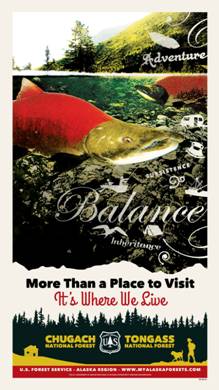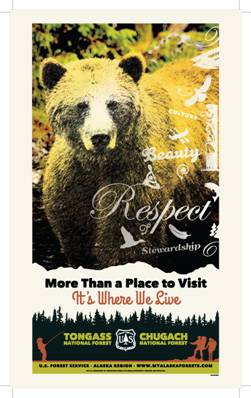The Chugach and Tongass National Forests have released two new posters in their series, More Than a Place to Visit—It’s Where We Live. The new 16×32 inch posters are available for free at your local Forest Service office.
The posters depict the link between bears, salmon, forests and streams, visually exploring the cycle of life that bear and salmon represent, and underscoring the importance of forests to animal and human communities.
Alaska’s first forest reserve, the Afognak Forest and Fish Culture Reserve, was established in 1892 expressly for the conservation of salmon. Today, five species of salmon thrive in the rivers of Alaska’s national forests: the king, coho, sockeye, pink, and chum.
More than 100 million salmon are caught each year on the Chugach and Tongass National Forests. As salmon become plentiful, bears become more active. Respecting and living alongside bears is a fact of life for Alaskans.
The posters blend photography, art, and words to evoke the spirit and the beauty of these wonderful public lands. Rich in symbolism and representation, the powerful design of these posters encourages viewers to explore and respect the wild lands and inhabitants of Alaska’s national forests.
The Chugach and Tongass are the two largest national forests in the nation. Together, they encompass more than 22 million acres and provide a backyard experience for nearly two-thirds of Alaskans. From Anchorage to Juneau, Ketchikan to Cordova, Prince of Wales to Prince William Sound, Alaskans in 43 different communities recreate, make a living, and meet the subsistence needs of their families in and around Alaska’s national forests.
Learn more at http://www.fs.usda.gov/chugach http://www.fs.usda.gov/tongass or myalaskaforests.com
This stunning landscape stretches across south-central Alaska, from the salty waters and snowy peaks of Prince William Sound to the fabulous salmon and trout streams of the Kenai Peninsula, covering an area the size of New Hampshire. It is one of the few places left in the world where glaciers still grind valleys into the hard rock of the earth.






